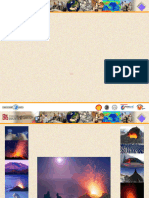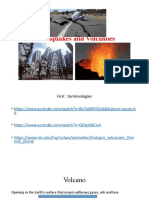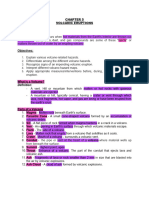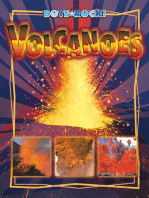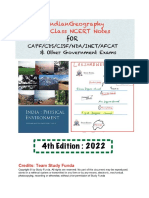Geomorphologynoteslecture3 PDF
Uploaded by
Ashpreet KaurGeomorphologynoteslecture3 PDF
Uploaded by
Ashpreet KauriLead IAS Academy Contact 9855000319
UPSC FREE FOUNDATION BATCH
Geomorphology Lecture: 3 Notes
VULCANISM
• Volcanism is the phenomenon of movement of the Magma through the interior of the earth towards
earth surface.
• A volcano is a vent or a fissure in the crust from which lava (molten rock), ash, gases, rock fragments
erupt from a magma chamber below the surface.
Causes of volcanism
• There is a huge temperature difference between the inner layers and the outer layers of the earth due to
the differential amount of radioactivity. This temperature difference gives rise to convectional
currents in the mantle.
• At the divergent boundary, molten, semi-molten and sometimes gaseous material appears on earth at
the first available opportunity.
• The earthquakes here may expose fault zones through which magma may escape (fissure type
volcano).
• At the convergent boundary, the subduction of denser plate creates magma at high pressure which will
escape to the surface in the form of violent eruptions.
Types of Lava:
Acidic/Andesitic/Felsic Lava
• These lavas are highly viscous with a high
melting point.
• They are light-colored, low density, and
have high percentage of silica.
• The resultant volcanic cone is therefore
stratified (hence the name stratovolcano)
and steep-sided.
• The rapid solidifying of lava in the vent
obstructs the flow of the out-pouring lava,
resulting in loud explosions, throwing out
many volcanic bombs or pyroclasts.
• Sometimes the lavas are so viscous that they form a lava plug at the crater like that of Mt. Pelée
in Martinique.
• Andesitic lava flow occurs mostly along the destructive boundaries (convergent boundaries).
https://t.me/+O63A8JbZAq5lMjE1 iLead IAS Academy Keep It Simple
Plot no. 11/12, 2nd floor, Dainik Bhaskar Building
iLead IAS Academy Contact 9855000319
Basic/Mafic/Basaltic Lava
• These are the hottest lavas, about 1,000
°C and are highly fluid.
• They are dark colored basalt, rich in iron
and magnesium but poor in silica.
• They flow out of volcanic vent quietly and
are not very explosive.
• Due to their high fluidity, they flow
readily with a speed of 10 to 30 miles per
hour.
• They affect extensive areas, spreading
out as thin sheets over great distances before they solidify.
• The resultant volcano is gently sloping with a wide diameter and forms a flattened shield or
dome.
• Shield type lava flow is common along the constructive boundaries (divergent boundary).
VOLCANIC LANDFORMS:
• Volcanic landforms are divided into extrusive and intrusive landforms based on whether magma cools
within the crust or above the crust.
• Rocks formed by cooling of magma within the crust are called Plutonic rocks.
• In general, the term ‘Igneous rocks’ is used to refer all rocks of volcanic origin.
Extrusive Volcanic Landforms
• Fissure Vent
• A fissure vent (volcanic fissure) is a narrow, linear
volcanic vent through which lava erupts, usually
without any explosive activity.
• The vent is often a few meters wide and may be many
kilometres long.
• Fissure vents are common in basaltic volcanism (shield
type volcanoes).
Conical Vent
• A conical vent is a narrow cylindrical vent through
which magma flows out violently.
• Conical vents are common in andesitic volcanism (composite or stratovolcano).
https://t.me/+O63A8JbZAq5lMjE1 iLead IAS Academy Keep It Simple
Plot no. 11/12, 2nd floor, Dainik Bhaskar Building
iLead IAS Academy Contact 9855000319
Mid-Ocean Ridges
• The system of mid-ocean ridges stretches for more than 70,000 km across all the ocean basins.
• The central portion of the mid-ocean ridges experiences frequent eruptions.
• The lava is basaltic (less silica and hence less viscous) and causes the spreading of the seafloor.
Composite Type Volcanic Landforms
• They are conical or central type volcanic landforms.
• Along with andesitic lava, large quantities of pyroclastic material and ashes find their way to the
surface.
• Andesitic lava along with pyroclastic material accumulates in the vicinity of the vent openings
leading to the formation of layers, and this makes the mounts appear as a composite volcano or a
stratovolcano (divided into layers).
• Mount Stromboli (the Lighthouse of the Mediterranean), Mount Vesuvius, Mount Fuji are examples.
Fissure Type Flood Basalt Landforms (Lava Plateaus)
• Sometimes, a very thin magma escapes through cracks and fissures in the earth's surface and flows
after intervals for a long time, spreading over a vast area, finally producing a layered, undulating
(wave-like), flat surface.
• Example: Siberian Traps, Deccan Traps, Snake Basin, Icelandic Shield, Canadian Shield.
Crater
• A crater is an inverted cone-shaped vent through which the magma flows out. When the volcano is
not active the crater appears as a bowl-shaped depression.
• When water from rain or melted snow gets accumulated in the crater, it becomes a crater lake.
Caldera
• In some volcanoes, the magma chamber below the surface may be emptied after volcanic eruptions.
• The volcanic material above the chamber collapses into the empty magma chamber, and the collapsed
surface appears like a large cauldron-like hollow (tub shaped) called the caldera.
• When water from rain or melted snow gets accumulated in the caldera, it becomes a caldera lake (in
general, the caldera lakes are also called crater lakes).
• For example, Lake Toba (Indonesia) formed after its super volcanic eruption around 75,000 years
ago.
Cinder cone
• A cinder cone is a steep circular or oval-shaped hill of loose pyroclastic fragments that have been
built around a volcanic vent.
Lava Dome
• A lava dome (volcanic dome) is a mound-shaped protrusion (a structure that extends outside the
surface) resulting from the slow extrusion (coming out) of viscous lava from a volcano.
https://t.me/+O63A8JbZAq5lMjE1 iLead IAS Academy Keep It Simple
Plot no. 11/12, 2nd floor, Dainik Bhaskar Building
iLead IAS Academy Contact 9855000319
• In Lava domes, viscous magma piles up around the vent.
• The magma does not have enough gas or pressure to escape, although sometime later after sufficient
pressure builds up, it may erupt explosively.
Intrusive Volcanic Landforms
• Magma, while thrusting its way up to the surface may cool and solidify within the crust as
Plutonic Rocks- resulting in Intrusive Igneous Landforms
Batholiths:
• Large magmatic materials that cool down at great depths in the crust to form large domes.
• Appear on the Earth’s surface only after denudation removes the overlying material – example- the
uplands of Brittany, France
• Cover large areas (hundreds of Kilometres) and may be several kilometres deep- gigantic bodies
• Huge mass of igneous rocks- mainly Granite
• Large masses of magma rising upwards metamorphosed the country rocks (rocks with which
magma came in contact)- these metamorphosed rocks together with the solidified magma gave rise to
extensive batholiths
Laccoliths
• Dome shaped as well
• Have a level base
• Are connected by a pipe like conduit from below
• Resemble the surface of the volcanic domes of composite volcanoes
• It arches up the overlying strata of sedimentary rocks
• Karnataka plateau in Deccan is spotted with Granite rocks- peeled off laccoliths and batholiths
Lapolith
• As and when lava moves upwards, a part of it may move in a horizontal direction when it finds a
weak plane
• When it is reset in different forms, it is called by different names.
• Saucer-shaped concave masses facing upwards are called Lapoliths.
Phacolith
• Wavy mass of rocks
• Have a definite conduit leading to the magma chambers.
• Lens shaped- occupies the crest of an anticline or bottom of a syncline
Sill
• Perhaps the most common intrusive landform
• Nearly horizontal rock bodies
• Called Sheets when thinner
https://t.me/+O63A8JbZAq5lMjE1 iLead IAS Academy Keep It Simple
Plot no. 11/12, 2nd floor, Dainik Bhaskar Building
iLead IAS Academy Contact 9855000319
• Get solidified between horizontal sedimentary rocks
Dyke
• Also very common
• Formed when lava makes its way through cracks and fissures developed on land
• It solidifies almost perpendicular to the ground
• Commonly found in western Maharashtra
• Considered to be the feeders for the eruptions that led to the development of the Deccan Traps
TYPES OF VOLCANOES
• Depending on the frequency of eruption
▪ Active
▪ Dormant
▪ Extinct
Active
• Erupt frequently
• Stromboli (Italy), Mauna Loa of Hawaii and Barren Island of Andaman and Nicobar Islands of India
Dormant
• Sleeping volcanoes
• Have not erupted in the recent past
• Yet have a possibility of erupting in the future
• Mt Vesuvius (Italy) and Mt. Krakatau (Indonesia)were thought to be extinct but erupted suddenly
Extinct
• Not erupted for a long time
• Unlikely to erupt in the future.
• Mt. Fujiyama in Japan, Mt. Kilimanjaro in Tanzania
On the basis of nature of eruption and form developed on the surface, they are classified into following
types:
1. Shield Volcanoes: These are made up of basalt, a type of lava that is very fluid when erupted. They
become explosive when water gets into the vent. They develop into a cinder cone. Hawaiian
volcano is an example of this category.
2. Composite cone volcanoes: They are also called 'strato volcanoes'. They are cone-shaped
volcanoes composed of layers of lava, ash and rock debris. Mount Vesuvius and Mount St. Helens
are examples of composite volcanoes.
3. Cinder Cone Volcano : It forms when magma is thrown out to the surface, cooled in to ash and
cinders and settled around the mouth of volcano. It is less dangerous than other volcanoes.
https://t.me/+O63A8JbZAq5lMjE1 iLead IAS Academy Keep It Simple
Plot no. 11/12, 2nd floor, Dainik Bhaskar Building
iLead IAS Academy Contact 9855000319
Shield Volcanoes Composite cone volcanoes Cinder Cone Volcano
4. Lava Dome: Unlike composite and shield volcanoes, lava domes are of
significantly smaller structure. They are formed when the lava is too
viscous to flow to a great distance. As the lava dome slowly grows, the
outer surface cools and hardens as the lava continues to pile within.
Eventually, the internal pressure can shatter the outer surface, causing
loose fragments to spill down its sides.
HOTSPOT VOLCANISM
https://t.me/+O63A8JbZAq5lMjE1 iLead IAS Academy Keep It Simple
Plot no. 11/12, 2nd floor, Dainik Bhaskar Building
iLead IAS Academy Contact 9855000319
• Hotspot Volcanism is somewhat different from the other types because this type of volcanism
occurs not at the margins but at the interior parts of the lithospheric plates.
• Well known examples include Hawaiian Hotspot Volcanism, Yellowstone Hotspot Volcanism and
Reunion Hotspot Volcanism.
Hot spot
• "Hotspot" refers to an area in the Earth s mantle from where hot plumes rise upward through
the process of convection and form volcanoes on the overlying crust.
• This heat facilitates the melting of rock at the base of the lithosphere. • The melted rock, known as
magma, often pushes through cracks in the crust to form volcanoes.
• Hot-spots are relatively fixed in comparison to the plates.
Mantle plumes:
Hotspot volcanism occurs at abnormally hot centres known as the mantle plume.
• Mantle plumes = Exceptionally hot areas fixed deep below the Earth’s crust
• These mantle plumes are almost like lava lamps consisting of a rising bulging head fed by a long,
narrow tail that originates from the mantle.
NOTE: LAHAR
A lahar is a violent type of mudflow or debris flow composed of a slurry of pyroclastic material, rocky
debris and water. The material flows down from a volcano, typically along a river valley.
Lahars are extremely destructive as they flow fast and can engulf entire settlements in a matter of
minutes.
Effects of Volcanic Activities
Destructive effects of volcano
Showers of cinders and bombs can cause damage to life and properties. Sometimes ash can precipitate
under the influence of rain and completely cover large areas.
The volcanic gases pose potential hazard to people, animals; agriculture, while sulphur dioxide gas can
lead to acid rain and air pollution.
Positive Effects of Volcanoes
Volcanism creates new landforms. Volcanic rocks yield very fertile soil upon weathering and
decomposition.
The Kimberlite rock of South Africa, the source of diamonds, is the pipe of an ancient volcano.
In the vicinity of active volcanoes, waters in the depth are heated from contact with hot magma giving
rise to springs and geysers. The Puga valley in Ladakh region and Manikaran (Himachal Pradesh) are
promising spots in India for the generation of geothermal electricity.
Distribution of Volcanoes across the World:
Most known volcanic activity and the earthquakes occur along converging plate margins and mid-oceanic
ridges. The major regions of volcanic distributions are as follows.
1. Pacific Ring of Fire
https://t.me/+O63A8JbZAq5lMjE1 iLead IAS Academy Keep It Simple
Plot no. 11/12, 2nd floor, Dainik Bhaskar Building
iLead IAS Academy Contact 9855000319
Circum-Pacific region, popularly termed the ‘Pacific Ring of Fire’, has the greatest concentration of
active volcanoes. Volcanic belt and earthquake belt closely overlap along the ‘Pacific Ring of Fire’. It is
estimated to include two-thirds of the world volcanoes.
2. Mid Atlantic Region
The Mid Atlantic Region coasts has comparatively fewer active volcanoes but many dormant or extinct
volcanoes, example. St. Helena, Cape Verde Islands and the Canary Islands. But the volcanoes of Iceland
and the Azores are active.
3. The Great Rift valley of Africa
In Africa some volcanoes are found along the East African Rift Valley. Kilimanjaro and Mt. Kenya are
extinct volcanoes. The only active volcano in West Africa is Mt. Cameroon.
4. Mediterranean Region
Volcanoes of the Mediterranean region are mainly associated with the Alpine folds. Example, Mt.
Vesuvius and Mt. Stromboli (known as the Light House of the Mediterranean Sea).
5. Other Regions
Elsewhere in the interiors of continents of Asia, North America and Europe active volcanoes are rare.
There are no volcanoes in Australia.
Folding Faulting
• Folds are bends in the rocks that are due to compressional forces. Faults are due to tensional forces
along which displacements of rocks take pace
• Folding occurs when compressional force is applied to rocks that are ductile or flexible. Faults occur
when forces operating in opposite directions leads to tension and as a result rocks develop cracks on
the fissure.
• Rocks that lie deep within the crust and therefore are under high pressure are generally ductile and
particularly susceptible to folding without breaking. Rock layers that are near the surface and not
under high confining pressure are too rigid to bend into folds, but if the tectonic plates are too large
rocks break.
• Folds form under varied conditions of stress, pore pressure, and temperature gradient, as evidenced by
their presence in soft sediments, the full spectrum of metamorphic rocks with normal dip-slip faults,
the rock masses compress on each other vertically, and the rock moves heads downward.
• Folds are commonly formed by shortening of existing layers, but may also be formed as a result of
displacement on a non-planar fault A fault plane is the plane that represents the fracture surface of a
fault. A fault trace or fault line is a place where the fault can be seen or mapped on the surface.
• A fold surface seen perpendicular to its shortening direction can be divided into hinge and limb
portions, the limbs are the flanks of the fold and the hinge zone is where the limbs converge. A fault
zone is a cluster of parallel faults. However, the term is also used for the zone of crushed rock along a
single fault.
• Minor folds are quite frequently seen in outcrops; major folds seldom are except in the more arid
countries. Minor folds can, however, often provide the key to the major folds they are related to All
faults have a measurable thickness, made up of deformed rock characteristic of the level in the crust
https://t.me/+O63A8JbZAq5lMjE1 iLead IAS Academy Keep It Simple
Plot no. 11/12, 2nd floor, Dainik Bhaskar Building
iLead IAS Academy Contact 9855000319
where the faulting happened, of the rock types affected by the fault and of the presence and nature of
any mineralizing fluids.
• Folding resulted in the Himalayan Mountains, Alps etc Faulting results in the formation of block
mountains and river valleys like the Narmada.
Types of Folds
The type of fold depends on the nature of the rock, the intensity of compression forces, etc. The types of
the fold can be many but we will deal with five of the following.
1. When compressional force is equal from both sides, the angle of the limb is same on both sides. Such
a fold is called symmetrical fold.
2. When compressional force is more from one end, one limb is steeper than the other. Such a fold is
called asymmetrical fold.
3. Isoclinal folds are similar to symmetrical folds, but these folds both have the same angle and are
parallel to each other. 'iso' means 'the same' (symmetrical), and 'cline' means 'angle,' so this name
literally means 'the same angle.
4. When one limb of the fold is pushed over the other limb of the fold, it is called as over turned fold.
Limbs are seldom horizontal.
5. When one side of the fold is pushed so much that it lies positioned over the other, such a fold is called
recumbent fold.
TYPES OF FAULTS
Normal Fault
Vertical displacement of the crust is called a normal
fault. The normal fault is caused by tensional forces
where plates diverge. One block lies above the other
(hanging wall). The other block lies below the fault
(footwall).
https://t.me/+O63A8JbZAq5lMjE1 iLead IAS Academy Keep It Simple
Plot no. 11/12, 2nd floor, Dainik Bhaskar Building
iLead IAS Academy Contact 9855000319
When movement occurs along a normal fault, the hanging wall slips downward.
Horst and Graben (valley and range) refers to a type of topography created when the earth's crust is
pulled apart. This process, called extension, can stretch the crust up to 100% of its original size. As the
crust is strained in this way, normal faults develop and blocks of the crust drop down to form grabens, or
valleys. The end result of this is a vast landscape of alternating valleys and ridges. The western United
States is an example of this, in the physiographic province known as the Basin and Range.
Reverse Fault
A reverse fault is a horizontal displacement of the
crust. It is formed where two fractured blocks move
towards each other. It is caused by compressional
forces along convergent plate boundaries. One side of
the fault lies at an angle above the other.
Accompanying the folding is a form of faulting in
which slices of rock move over the underlying rock on
fault surfaces with gentle inclination angles. These are
called overthrust faults. The individual rock slices,
https://t.me/+O63A8JbZAq5lMjE1 iLead IAS Academy Keep It Simple
Plot no. 11/12, 2nd floor, Dainik Bhaskar Building
iLead IAS Academy Contact 9855000319
called thrust sheets, are carried many tens of kilometers over the underlying rock. In the European Alps,
thrust sheets of this kind were named nappes
Shear Fault / Transform Fault/ Strike – Slip Fault
It is created by shearing along transform boundaries. Rocks
on either side of fault slip past each other sideways with
little up or down motion. It mostly occurs in the ocean
basin and connects offsets in the MID OCEANIC RIDGE.
MOVEMENT OF THE INDIAN PLATE
The Indian plate includes Peninsular India and the
Australian continental portions.
Indian Plate Boundaries
• The subduction zone along the Himalayas forms the
northern plate boundary in the form of continent —
continent convergence.
• East- In the east, it extends through Rakinyoma
Mountains (ArakanYoma) of Myanmar towards the
island arc along the Java Trench. The eastern margin
is a spreading site lying to the east of Australia in the
form of an oceanic ridge in SW Pacific.
• West- The Western margin follows Kirthar Mountain
of Pakistan. It further extends along the Makrana
coast (Pakistan and Iranian coasts) and joins the
spreading site from the Red Sea rift (Red Sea rift is
formed due to divergence of Somali plate and
Arabian plate) southeastward along the Chagos
Archipelago (Formed due to hotspot volcanism).
• The boundary between India and the Antarctic plate
is also marked by oceanic ridge (divergent boundary)
running in roughly W-E direction and merging into
the spreading site, a little south of New Zealand.
• India was a large island situated off the Australian
coast, in a vast ocean.
• The Tethys Sea separated it from the Asian continent
till about 225 million years ago.
https://t.me/+O63A8JbZAq5lMjE1 iLead IAS Academy Keep It Simple
Plot no. 11/12, 2nd floor, Dainik Bhaskar Building
iLead IAS Academy Contact 9855000319
• India is supposed to have started her northward journey about 200 million years ago at the time
when Pangaea broke.
• India collided with Asia about 40-50 million years ago causing rapid uplift of the Himalayas.
• About 140 million years before the present, the subcontinent was located as south as 50◦ S. latitude.
• The two major plates were separated by the Tethys Sea and the Tibetan block was closer to the
Asiatic landmass.
https://t.me/+O63A8JbZAq5lMjE1 iLead IAS Academy Keep It Simple
Plot no. 11/12, 2nd floor, Dainik Bhaskar Building
You might also like
- 20KJ0185 - Construction Maintenance of Flood Mitigation Structures and Drainage System, Construction of Ozamis City Drainage System, Package 2No ratings yet20KJ0185 - Construction Maintenance of Flood Mitigation Structures and Drainage System, Construction of Ozamis City Drainage System, Package 222 pages
- Volcanoes: Grade 9, Module 3 Lesson 1.1No ratings yetVolcanoes: Grade 9, Module 3 Lesson 1.136 pages
- Unit 1.3: Volcanic Activity: MR - McmahonNo ratings yetUnit 1.3: Volcanic Activity: MR - Mcmahon43 pages
- Earth'S Materials and Processes: Marilyn P. Mifuel100% (1)Earth'S Materials and Processes: Marilyn P. Mifuel57 pages
- Prepared By: Mrs. Amany Adel Gaber HussienNo ratings yetPrepared By: Mrs. Amany Adel Gaber Hussien127 pages
- PLATE - MOVEMENTS - Year 9 - 10 Oct 2019No ratings yetPLATE - MOVEMENTS - Year 9 - 10 Oct 201934 pages
- Nature and Types of Volcanoes Autosaved 1No ratings yetNature and Types of Volcanoes Autosaved 131 pages
- FAA - AC 120-60B - Ground Deicing and Anti-Icing Program Document InformationNo ratings yetFAA - AC 120-60B - Ground Deicing and Anti-Icing Program Document Information20 pages
- Life Science Stories Comprehension DesertsNo ratings yetLife Science Stories Comprehension Deserts3 pages
- The Earthquake: Colegio Cerro Grande Miss Marta Pía Rivera La Serena English DepartmentNo ratings yetThe Earthquake: Colegio Cerro Grande Miss Marta Pía Rivera La Serena English Department3 pages
- Classification of Lacustrine Sediments Based On Sedimentary ComponentsNo ratings yetClassification of Lacustrine Sediments Based On Sedimentary Components14 pages
- 2024 Geo Grade 11 PRE June Exam CLUSTER 2 Marking GuidelinesNo ratings yet2024 Geo Grade 11 PRE June Exam CLUSTER 2 Marking Guidelines10 pages
- Natural Calamity Means Natural Disaster Caused by Nature. Bangladesh Is A Land of NaturalNo ratings yetNatural Calamity Means Natural Disaster Caused by Nature. Bangladesh Is A Land of Natural1 page
- Natural Hazards 4th Edition Keller Test Bank100% (45)Natural Hazards 4th Edition Keller Test Bank21 pages
- A Industrial Visit Report In: "400 KV Substation, Khedamara"No ratings yetA Industrial Visit Report In: "400 KV Substation, Khedamara"10 pages
- 20KJ0185 - Construction Maintenance of Flood Mitigation Structures and Drainage System, Construction of Ozamis City Drainage System, Package 220KJ0185 - Construction Maintenance of Flood Mitigation Structures and Drainage System, Construction of Ozamis City Drainage System, Package 2
- Earth'S Materials and Processes: Marilyn P. MifuelEarth'S Materials and Processes: Marilyn P. Mifuel
- FAA - AC 120-60B - Ground Deicing and Anti-Icing Program Document InformationFAA - AC 120-60B - Ground Deicing and Anti-Icing Program Document Information
- The Earthquake: Colegio Cerro Grande Miss Marta Pía Rivera La Serena English DepartmentThe Earthquake: Colegio Cerro Grande Miss Marta Pía Rivera La Serena English Department
- Classification of Lacustrine Sediments Based On Sedimentary ComponentsClassification of Lacustrine Sediments Based On Sedimentary Components
- 2024 Geo Grade 11 PRE June Exam CLUSTER 2 Marking Guidelines2024 Geo Grade 11 PRE June Exam CLUSTER 2 Marking Guidelines
- Natural Calamity Means Natural Disaster Caused by Nature. Bangladesh Is A Land of NaturalNatural Calamity Means Natural Disaster Caused by Nature. Bangladesh Is A Land of Natural
- A Industrial Visit Report In: "400 KV Substation, Khedamara"A Industrial Visit Report In: "400 KV Substation, Khedamara"
















